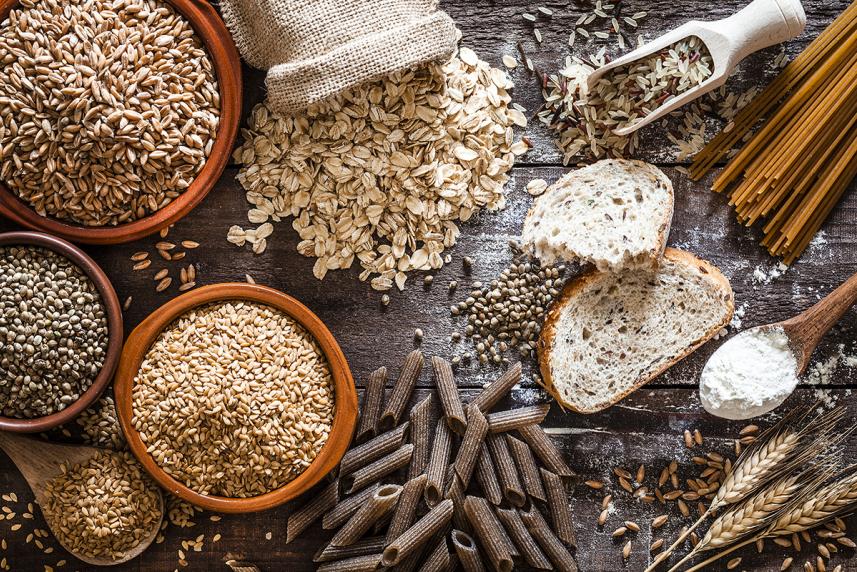6 simple ways to add more grains to your diet
Eating more whole grains has lots of health benefits — but including them in your meal planning can be tricky. This guide can help.

Whole-grain foods are super popular: A 2023 Whole Grains Council poll showed that 61% of Americans are passing up white bread and rice and saying “Yes, please” to whole grains, choosing everything from a peanut butter sandwich on whole-wheat bread to a side dish of brown rice. The top reasons? Health benefits and good taste.
That’s a smart choice, says Lauren O’Connor, a registered dietitian nutritionist and author of The Complete Healthy Eating Cookbook: Fuss-Free Recipes and Flexible Meal Plans for Healthier Living. “Eating a variety of whole grains provides you with a wide range of vitamins, minerals, and other important nutrients,” she says. “And preparing whole grains can be easy and convenient.”
Plus, these delicious nuggets have plenty of health benefits. Studies show that people who eat more whole grains have a lower risk for cardiovascular disease, type 2 diabetes, and some forms of cancer. In a 2021 Tufts University study, people who ate more whole grains over a period of 18 years had the smallest increases in waist size — that’s a sign of less abdominal fat. They also had the lowest raises in blood pressure and blood sugar levels.
Why? Researchers say the fiber in whole grains can help control appetite and keep cholesterol levels in check. (Soluble fiber helps trap fats in your digestive system, ushering it out of your body with bowel movements and lowering your cholesterol.) Whole grains are digested more slowly than refined grains (like white bread, white-flour crackers, and wraps), which keeps blood sugar levels lower and steadier and may even encourage your body to burn more fat as fuel, the Tufts researchers say.
Did you know HMSA members have access to personalized support to help you manage your health and well-being? Learn more here.
What’s so special about whole grains?
Whole grains are so good for you because they include the three nutritious parts of a kernel of grain:
- The carbohydrate-rich endosperm. That’s the inside of the grain, which has some B vitamins and minerals.
- The fiber-rich bran. That’s the grain’s outer layer. It also contains B vitamins, minerals like iron, copper, and zinc, as well as beneficial plant compounds called phytochemicals, which may help prevent chronic diseases.
- The nutrient-rich germ. That’s at the core of the grain, and it contains good fats, vitamins B and E, and phytochemicals.
Refined grains, on the other hand, don’t have the bran or germ, so they don’t have the nutritional benefits of whole grains.
Choosing whole grains
When it comes to whole grains, your choices are almost endless. Examples include whole wheat, oats, brown rice, and hulled barley. Other examples: quinoa, amaranth, teff, faro, Kamut, spelt, bulgur, buckwheat, and rye.
But it’s easy to get confused or misled by the packaging and appearance of breads, pasta, crackers, and other grain-based foods. Some products may look like good sources of whole grains, but they’re not. In a 2020 study, up to 51% of participants thought breads and crackers labeled “honey wheat,” “farmhouse 12-grain,” and “multigrain” contained at least half whole grains. But the ingredients lists revealed that they had less. The reason: Food manufacturers can use those label terms, as well as words like “wheat,” “made with cracked wheat,” or “stoneground,” on the labels of foods that are mostly refined grains, according to the Academy of Nutrition and Dietetics.
“Don’t go crazy trying to navigate the claims on the label,” says O’Connor says. “The most important thing is to look at the ingredients list on the package. If the list starts with a whole grain, it is a whole grain. If it doesn’t, look for something else.” You can also check the product’s nutrition facts panel, O’Connor adds. “A whole-grain product will have at least three grams of fiber per serving,” she says.

Use Find a Doctor on hmsa.com to search for a participating provider near you today.
Six easy ways to get more whole grains in your diet
According to the U.S. Department of Agriculture’s Dietary Guidelines for Americans, 2020-2025, at least half of your daily grains should be whole grains. Chances are, you need to add more to your diet. In the Whole Grains Council survey, 77% of respondents said they wished they ate even more. Looking for ways to boost your intake of whole grains? Here are some tips:
Plan ahead. Some grains just need longer cooking times. Brown rice, for example, takes 45 minutes. Hulled barley may take as long as 60 minutes. And wheat berries and the ancient wheat grain called Kamut each need to be cooked between 45 and 60 minutes — and that’s after an overnight soak.
“Just remember to get them started early,” O’Connor says. “They’ll cook while you’re doing other things.” Or invest in a rice cooker, which automatically switches from cooking to warming mode when grains are ready. Bonus: These cookers aren’t just for rice — they can be used for a wide variety of grains.
Try whole grains that cook as fast as pasta. Get dinner on the table fast with a whole grain cooked from scratch. Try bulgur, a precooked and dried whole-wheat product that cooks up in just 10 minutes and delivers more fiber than oats.
Quinoa, a native South American staple, is ready in 12 to 15 minutes and has six grams of protein in three-quarters of a cup. Or make a batch of whole-wheat couscous, a tiny pasta that cooks up in 10 minutes. Just mix with boiling water and let sit for 10 minutes.
Make almost any grain cook even faster. Soaking whole grains for a few hours ahead of time can speed up cooking time. So can making grains like brown rice, farro, and wheat berries the way you would cook pasta — boil them in a large pot with lots of extra water, then drain when tender.
Stock your freezer and pantry with precooked whole grains. Frozen or microwavable whole grains are ready in as little as 90 seconds. You’ll find everything from quinoa and brown rice to multigrain mixes in stores and online.
Cook, cool, enjoy tomorrow — and the day after. Make a pot of your favorite whole grain, then store in the fridge in a sealed container, O’Connor suggests. Grains keep for three to four days this way. Reheat in the microwave with a little water, drop into soups or stews, or enjoy as a cold salad with veggies, greens, and dressing.
Eat a variety. Each whole grain offers a different mix of nutrients. Oats, for example, provide protein, selenium, fiber, iron, and manganese. So mix up your menu — try lots of different grains for a diet that’s healthy, well-balanced, and delicious.
Sources:
Whole grains basics and daily whole grains recommendations: U.S. Department of Agriculture
Whole Grain Consumer Insights Survey data: Whole Grains Council
Tufts study of whole grain consumption and disease risk: The Journal of Nutrition
Study showing consumer confusion around food labels: Public Health Nutrition
H8481_8750_1295101_3MCB2206_26_C | H3832_8750_1295101_3MCB2184_26_C
© 2025, Linkwell Health, Inc. All content owned or licensed by Linkwell Health, Inc. All rights reserved.
